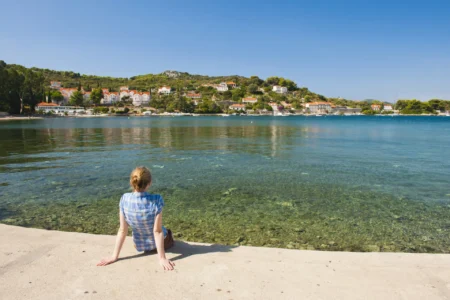Croatia’s Elafiti Islands are just a stone’s throw away from Dubrovnik (well, that is if you can throw hard – at least 12 kilometers), and quickly becoming an important attraction in Croatia.
Still, even the main three islands in the archipelago (Kolocep, Lopud and Sipan) are more silent and less traveled than Dubrovnik, but with plenty of goodies on offer, including tons of opportunities to relax in natural surroundings, with few people around.
This is where you go when you want a slice of authentic Adriatic life, stunning scenery, and a side of local history – with just enough hidden corners to make you feel like you’ve discovered your own private paradise. This is the he antidote to overcrowded beaches and tourist-packed streets.
Today, I will go in-depth and share everything you should know about the Elafiti islands (or Elahpiti), including tips that locals have shared with me over the years, as well as things to do on each of the main islands – and a few hidden gems thrown in for good measure.
Where Are the Elafiti Islands and Why Should You Care?
The Elafiti Islands are a small archipelago in the Adriatic Sea, stretching northwest of Dubrovnik and sandwiched between the coast and the larger island of Mljet.
The group actually consists of 13 islands, though most people only talk about the three main (and inhabited) ones: Koločep, Lopud, and Šipan. The rest – names like Daksa, Ruda, Jakljan, and Olipa – are mostly wild, uninhabited, or private, because that’s a thing nowadays.
The name “Elafiti” comes from the Greek word for deer – elafos. Centuries ago, these islands were home to wild deer, though today you’re more likely to spot sea birds and the occasional pod of dolphins than a stag.
The islands have long provided a peaceful retreat from the mainland, favored by Dubrovnik’s nobility for centuries. Even today, you’ll find old stone villas (some of which also offering accommodation, so that you can feel like royalty too), sleepy fishing villages, and generally a slower pace of life.
If you’re looking for a place to truly unwind, enjoy nature, and recharge – while being close enough to Dubrovnik for a day trip or more – the Elafiti Islands are the perfect choice. Prepare for your trip by reading some fun facts about Croatia.
Getting to the Elafiti Islands: Ferries, Tickets, and Tips
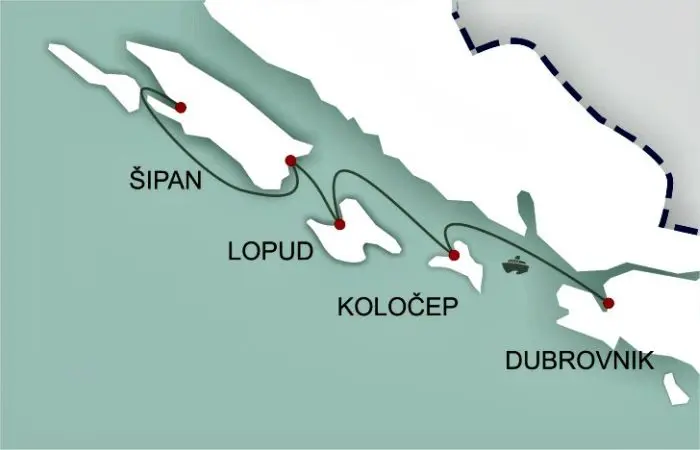
The three main islands are accessible by ferry from Dubrovnik (from the Gruz Harbor), and thankfully the system is easy once you know how it works.
Just look at the image above and you can quickly tell that it’s all pretty straightforward!
The main operator is Jadrolinija, probably the most important ferry operator in the country. It offers daily ferries to the islands (multiple times per day, especially during the top season), with tickets available for purchase online or at the dock.
I recommend getting your ticket online to be 100% sure there’s still availability for your dates. There are two ferry types/lines:
Line 807 (foot passengers only): This line runs several times a day between Dubrovnik, Koločep, Lopud, and Šipan. Summer brings more frequent departures; in winter, service is reduced, so always double-check the latest schedule.
Car Ferry Line 831: If you need to bring a car, only Šipan allows vehicles, and the service is limited. Koločep and Lopud are entirely car-free – you’ll do all your exploring on foot or by bike.
Travel times: Dubrovnik to Koločep is about 30 minutes, to Lopud about 50 minutes, and to Šipan just over an hour, depending on the exact route and stops.
Private boat transfers and organized day trips are also available from Dubrovnik – like this affordable hop-on, hop-off full-day boat tour, or this popular one with drinks included on board and optional lunch.
The Main Elafiti Islands
Now, let’s focus a bit on each of the main islands: what to see, why visit, and a bit of history.
Koločep Island (Kalamota)
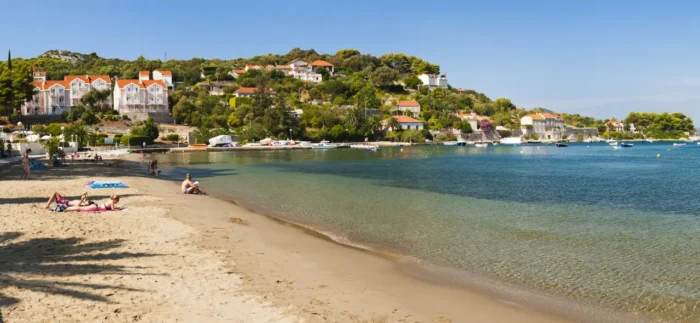
Koločep is the closest island to Dubrovnik, and the smallest of the main three. It’s just 2.5 square kilometers, and entirely car-free, making it perfect for slow-paced exploring. About 200 people live here year-round.
It has been a part of the Republic of Ragusa (Dubrovnik) in the 11th century. Its Slavic name was Kalamata, the name that derives from the Peloponnesian city of Kalamata, which is located in the Greek province of Messenia, and the same place from where my favorite olives come from. But I digress…
There are two main villages, Donje Čelo and Gornje Čelo, linked by a scenic 3km seaside path. This easy walk is a highlight, offering sea views, lush pine forests, and glimpses of old stone houses. Life here moves at a gentle rhythm – ideal if you want to switch off and recharge.
What to do in Kolocep?
Beaches: The island is home to some of the only sandy beaches near Dubrovnik, including the family-friendly one in Donje Čelo and the more secluded Đivan beach. The water is clean and shallow, perfect for swimming and snorkeling.
Visit the 13th-century Church of the Assumption of Mary in Donje Čelo, and the ancient St. Anthony church in Gornje Celo, as well as the St. Anthony of Padova one. Koločep has a surprising number of small chapels and churches, some dating back over a thousand years.
Activities: Swim, kayak, or simply walk around. There are no cars, so peace and quiet are guaranteed.
Caves: There are a few options, available by boat only, like the popular Blue Cave, or the Pigmej Cave.
Amenities: A couple of small shops and local restaurants, but little nightlife. Bring cash and check opening hours, especially off-season.
If you fall in love (or fall in love again) while here, I have prepared a list of traditional Croatian boy names for you, as well as girl names, just in case.
Lopud Island
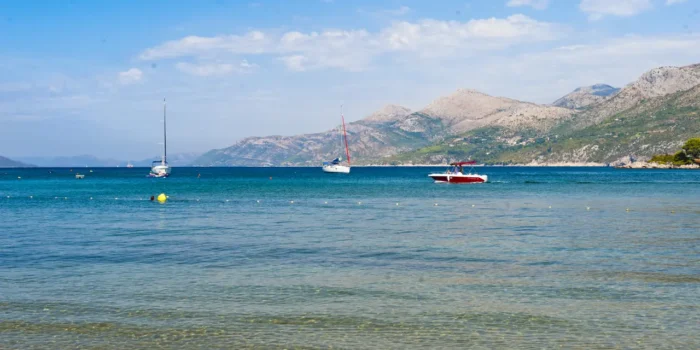
Lopud sits between Koločep and Šipan and is the most popular island for day trips. It’s known for its long sandy beaches and easygoing vibe. The main settlement, Lopud village, stretches along a crescent bay dotted with cafés and palm trees.
What to do in Lopud?
Šunj Beach: One of Croatia’s best sandy beaches, stretching nearly a kilometer. There’s a shallow entrance, making it safe for kids, and the walk from the ferry (about 20 minutes across the island) is scenic and easy. The first half of the beach is for everyone, while the far end is clothing-optional (a tradition on many Croatian beaches).
Speaking of clothing optional beaches (or FKK) in Croatia, check out my articles detailing them: guide to South Croatia naturist beaches, naturist beaches in Kvarner, or Best FKK Naturist Resorts in Istria.
Sights: Explore the old Franciscan monastery, small museums, and a botanical garden filled with Mediterranean plants. There are hidden ruins and centuries-old churches scattered around the island for those who like to wander.
Eat & Drink: Lopud has a few well-rated restaurants and beachfront bars, perfect for a long lunch or sunset drink.
Car-Free: Like Koločep, there are no cars here, so bring comfortable shoes or rent a bike.
Accommodation: More options than the other islands, from boutique hotels to guesthouses and private apartments.
Bonus: Although not as impressive as the French one, this island hosts The Eiffel Tower of Lopud. Make sure to visit if you have time.
Also read: Visiting Croatia on a Budget.
Šipan Island
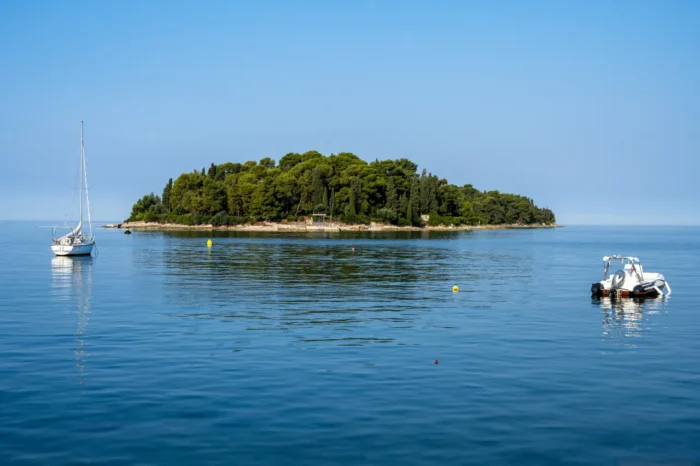
Šipan is the largest of the Elafiti Islands, and for those who want to explore, it has the most to offer. It covers about 16.5 square kilometers, with two main villages: Sudurad (where the ferries arrive) and Sipanska Luka, both with harbors, historic buildings, and plenty of local color.
What to do in Sipan?
History: Once a retreat for Dubrovnik’s wealthy families, Šipan is scattered with the ruins of summer villas, fortified houses, and ancient churches (over thirty in total). It’s a paradise for anyone who loves history or photography.
Nature: The interior is lush with olive groves, vineyards, fig and carob trees, and pomegranate orchards. You can walk or cycle between the villages (about 5km apart) and see the heart of island life.
Beaches: More pebbly than sandy, but the water is stunningly clear, and you’ll often have small coves to yourself.
Activities: Try local olive oil, sample homemade wine, or join a fishing tour with the locals.
Getting around: This is the only island where cars are allowed (and the car ferry runs here), but most visitors still explore on foot or by bike.
Amenities: There are a handful of restaurants, two small supermarkets, and generally more amenities than on the other islands.
Also read: BEST Summer Destinations in Croatia This Year.
Where to Stay on the Elafiti Islands
Staying overnight is the best way to truly experience the islands after the last ferry leaves and the daytrippers disappear. Sure, most people visiting the island are the daytrippers themselves, and that’s perfectly fine.
But if you want to spend at least a night on either island (or all), here are my recommendations:
- Koločep: Small guesthouses and family-run B&Bs are the norm. Book early in high season. My top picks: Kalamota Beach House (with infinity pool!) or Apartments Elica.
- Lopud: Offers the most variety, from the four-star Lafodia Sea Resort to smaller boutique hotels, private rooms, and apartments. Another top pick: Boutique Hotel Tomić.
- Šipan: A few boutique hotels (like Hotel Bozica in Suđurađ), plus apartments and private rooms scattered across the island. Another top pick: Apartment Tonka (with a breathtaking terrace).
If you’re traveling in peak season (July-August), reserve well in advance. Prices are generally 15-25% lower than Dubrovnik, and the experience is worlds apart.
Food and Dining: What to Expect
You won’t find a huge array of restaurants or international cuisine here, but what’s available is fresh, local, and satisfying, so I recommend going for the local konobas on the island and sampling delicious, traditional Croatian food.
What to eat? If you love seafood, you’re in for a treat: grilled fish, calamari, octopus salad… these are all freshly caught and delicious.
Also try the local specialties like the peka (meat or seafood slow-cooked under an iron bell), fresh figs, olives, homemade rakija, and local wine.
Shops: Each main island has at least one small grocery store, but selection is limited compared to the mainland. Stock up in Dubrovnik if you have special dietary needs.
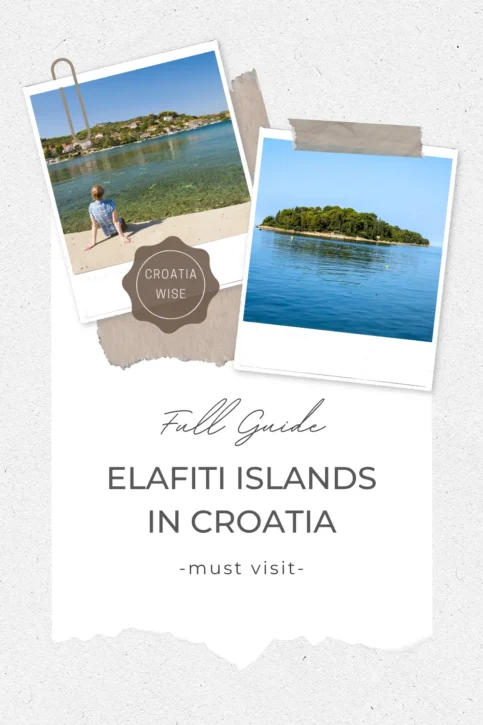
Wrapping Up
If you’re tired of crowds and want to experience authentic Adriatic life, the Elafiti Islands are a great choice, and their proximity to Dubrovnik makes them easy to get to.
So put off partying for a while and instead let yourself slow down a bit – you might just find yourself dreaming of coming back, like I always do. If you have anything to add (or questions to ask) comment below – I’d love to hear from you!

